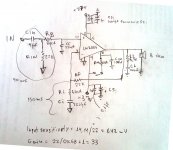Hallo Zakman35,
Don't remove Ci because the input resistance will be dependent on the output resistance of the pre-amplifier and that may change the output offset voltage of the LM3886 quite a lot.
And, if there is an output offset voltage on the pre-amplifier, that output offset voltage will be multiplied by 33 !!
Don't remove Cc because it prevents noise and - if necessarely - oscillation.
Marc.
Don't remove Ci because the input resistance will be dependent on the output resistance of the pre-amplifier and that may change the output offset voltage of the LM3886 quite a lot.
And, if there is an output offset voltage on the pre-amplifier, that output offset voltage will be multiplied by 33 !!
Don't remove Cc because it prevents noise and - if necessarely - oscillation.
Marc.
Good. Now, what is the AC (noise content) voltage of both DC rails?I measure dc voltage directly on the pins of the chip, both rails are exactly the same (+36.2V, -36.2V)
Can we return to the original subject: LM3886 without electrolytic feedback capacitor and (hardly) no DC offset voltage.
Zakman35 can you reply on that and on my last post?
Marc.
Zakman35 can you reply on that and on my last post?
Marc.
Don't remove Ci because the input resistance will be dependent on the output resistance of the pre-amplifier and that may change the output offset voltage of the LM3886 quite a lot.
And, if there is an output offset voltage on the pre-amplifier, that output offset voltage will be multiplied by 33 !!
Don't remove Cc because it prevents noise and - if necessarely - oscillation.
I install Ci back again (no changes at offset).
My pre amp (minidsp) is AC coupled at the output, so no dc from there.
I will try tomorrow to install back the Cc cap and report back.
Anyway, back to the topic.
What about adjusting - reducing positive's rails voltage to trim output offset to approximate 0mv. Is that an acceptable practice in power amps?
What about adjusting - reducing positive's rails voltage to trim output offset to approximate 0mv. Is that an acceptable practice in power amps?
Sure. You can run some led's on that rail, and you can add two of 4k7 1/4w bleeder resistors. It will make a very mild difference.
No, No, No, this isn't a solution at all!! (Or I don't understand it)
To trim out a offset voltage of let's say 6 mV, you have adjust the positive rail for a multiple of that. And that reduces your output power and induces distortion much earlier on one flank.
Why not use the way I proposed?
Marc.
To trim out a offset voltage of let's say 6 mV, you have adjust the positive rail for a multiple of that. And that reduces your output power and induces distortion much earlier on one flank.
Why not use the way I proposed?
Marc.
With the LM3886, your solution is probably better.Why not use the way I proposed? Marc.
Adjusting the supply voltage on one side in order to trim out the offset voltage is a bad solution for every amplifier.
Marc.
Marc.
The output offset should be substantially independent of the supply rail voltages in any opamp style amplifier.
However, a VAS stage without CCS supply/source will change it's Iq when supply voltage changes (both rails changing together), and this changed Iq with push/pull more or less current through the Collector load of the input transistor. This changed collector current will change the offset. This is one of the big disadvantages of a bootstrap feed to the VAS in a P3A (ESP) amplifier.
However, a VAS stage without CCS supply/source will change it's Iq when supply voltage changes (both rails changing together), and this changed Iq with push/pull more or less current through the Collector load of the input transistor. This changed collector current will change the offset. This is one of the big disadvantages of a bootstrap feed to the VAS in a P3A (ESP) amplifier.
Marc, I successfully applied your tip in my DIY studio monitor (with LM4766 - another BJT chipamp).
Previously, due to the low feedback resistance (200R and 3k3) in my design, I needed a large feedback capacitor. There was a slight but audible distortion, which is now gone or at least below my threshold 🙂.
Schematic here: http://rdimitrov.info/blog/show.php?entry=Minimalistic%20HIFI%20Bi-Amplified%20Speaker%20System
Thanks!
Previously, due to the low feedback resistance (200R and 3k3) in my design, I needed a large feedback capacitor. There was a slight but audible distortion, which is now gone or at least below my threshold 🙂.
Schematic here: http://rdimitrov.info/blog/show.php?entry=Minimalistic%20HIFI%20Bi-Amplified%20Speaker%20System
Thanks!
- Status
- Not open for further replies.
- Home
- Amplifiers
- Chip Amps
- LM3886 without electrolytic feedback capacitor and (hardly) no DC offset voltage
